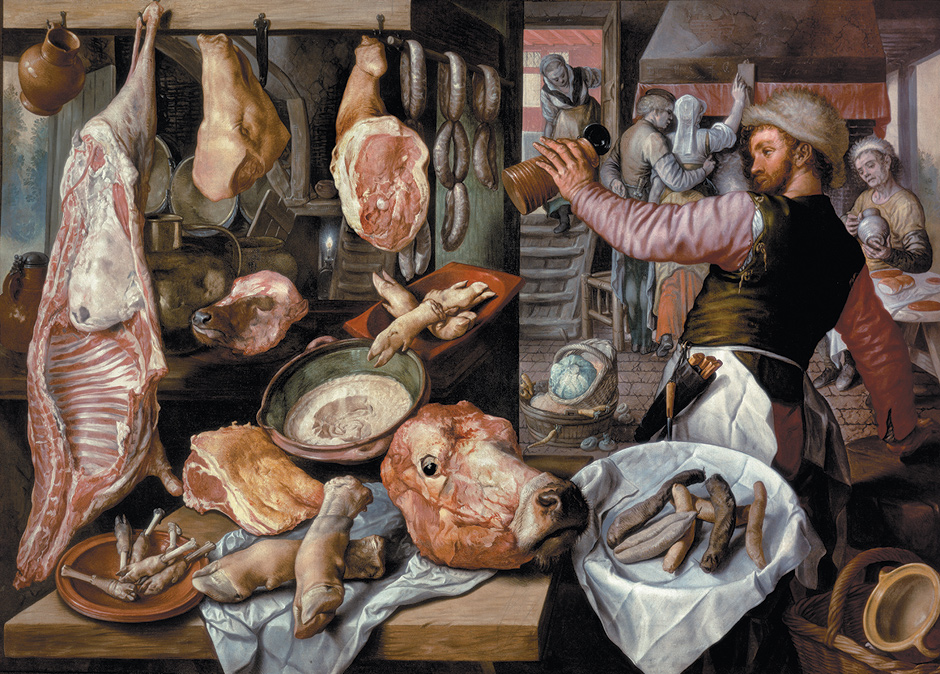As the familiar cultural world slowly, messily deconstructs itself, it was inevitable that cuisine would be transformed as well and that it would begin in California, especially the Los Angeles area with its lively authentic Latino-Asian food culture and its tutelary genius, the brilliant, obsessed Jonathan Gold, the only food writer to win a Pulitzer Prize for criticism. For her new book, Anything That Moves, Dana Goodyear, a staff writer for The New Yorker, “set out,” with Gold among her guides,
to explore the outer bounds of food culture, where the psychological, rational, legal, ethical, and indeed physical limits of edibility are being tried—and sometimes overturned. What I found was a collection of go-betweens, chefs, and adventurous eaters—scofflaws …who are breaking with convention to reshape the American palate.
“In our contemporary cuisine,” she writes,
I see anxiety behind the hedonism….After centuries of perfecting the ritual of “civilized” dining, there is a furious backpedaling, a wilding,…a post-apocalyptic free-for-all of crudity and refinement, technology and artlessness, an unimaginable future and a forgotten past.
This antinomian cuisine, she writes, “is about pleasure—pleasure heightened at the brink of calamity.” “If this is the end of the world,” one of her subjects declares, “give me a fork and a knife.” Goodyear’s subject is the manic transformation of cooking, but a sterner issue haunts her book, for cooking is inseparable from the civilization that it serves and whose tastes it accommodates.
So far the turn to defiantly radical cuisine is largely confined to the West Coast, but a transcontinental leap is probably inevitable, especially now that Gold has joined the Los Angeles Times as its syndicated food writer whose reports from Los Angeles are likely to be picked up by eastern media. Inspired food writing belongs not to a region but to the world. “As yet, however,” Goodyear writes in a puzzling overstatement, “everyone west of the Hudson cooks sous vide,” a costly and delicate technique in which fine cuts of meat or fish, together with seasonings, are placed in sealed plastic bags from which the air has been exhausted and cooked sous vide in a heat-controlled bath so that no flavor is lost in the cooking, a procedure whose temperature is strictly governed by health department regulations in New York, as Goodyear writes. But it makes no sense to say that everyone “west” of the Hudson uses this technique, for this implies that Cosentino and his comrades are sousvidists, whereas only the most soigné restaurants east as well as west of the Hudson use this procedure. More than a mere continent separates sous vide from the new California brutalism.
Though New York lacks the intense, diverse Latino-Asian culinary culture of Los Angeles and Jonathan Gold to report on it, it has its own transgressive preparations, including drinks: a New York bartender, for example, described by Goodyear
uses a rapid-infusion technique to make a smoky marijuana-mescal, double charging a canister of mescal and marijuana with nitrous. The first charge dissolves the gas into the mescal; the second forces the mescal to permeate the bud. When the canister is opened, releasing the pressure, the enhanced alcohol seeps back out of the plant…, he told me. “It’s so illegal on so many levels that no one talks about it openly.”
Superficially today’s apocalyptic alimentarians echo the Weathermen of the Sixties, but where the Weathermen blew up buildings and shot police officers, today’s radicals defy federal food laws, revel in unpasteurized milk, dine on fried grasshoppers, frog fallopian tubes, and Filipino balut—an unhatched duckling, cooked in its shell and eaten entire, beak, feathers, and bones.
Readers seeking a textbook example of le mot juste should consider “winciest” in the following paragraph:
Writing about a Uighur restaurant in Koreatown—“a nondescript…dining room where northeastern Chinese chefs prepare the Beijing version of Xinxiang barbecue for a Korean-speaking clientele”—[Gold] recommended what he called “the winciest dish in town: a sharp, glistening steel skewer stabbed through thin coins of meat sliced from a bull penis, which bubble and hiss when they encounter the heat of the fire, sizzling from proud quarters to wizened, chewy dimes.”
Though probably not with this fauvist dish in mind, the great Alice Waters of Chez Panisse, “the mother figure of organic, farm-to-table dining,” calls Gold “a harbinger of where American eating needs to go: toward diversity, away from monoculture,” a vast understatement as readers of Goodyear’s book will discover.
Goodyear describes in her survey of the new foodscape Chef Chris Cosentino’s annual Head to Tail dinner at Incanto, his San Francisco restaurant: “Two nights of extreme offal, prix fixe, that allow him to explore the outer boundaries of decency, manners, and taste,” which nicely describes Goodyear’s own journalistic approach to her subject. By 5:30 there was “a line out the door.” What awaited these eager carnivores was an amuse-bouche of whipped calves’ brains on toast or, at another dinner, “shaved tripe salad, pig’s brain prosciutto, and lamb heart. The final savory course before dessert would be braised pig head with grilled liver and large intestine.”
Advertisement
For Anthony Bourdain’s popular television show No Reservations, Cosentino had prepared “raw venison heart on a brioche made with pig skin; a goose-intestine soup…;cow’s brains and testicles,” the latter organs incorrectly attributed by Goodyear to the cow. Dessert was a donut filled with pork liver chocolate ganache followed by espresso made of pig’s blood, a “metallic flavor,” Goodyear writes, “familiar to anyone who’s ever been punched in the nose.”
One of Cosentino’s favorite dishes “involved asparagus (a diuretic), lamb kidney (a filter), and a bright yellow lemon vinaigrette, which he turned into a fluid gel with agar and sprinkled around the plate’s edge, like drops on the rim of the bowl.” Throughout her book Goodyear remains cheerfully nonjudgmental except for the two or three times when she starts to throw up but manages not to.
The progenitor of this transgressive fleischgeist is a Londoner, Fergus Henderson, who in 1995 opened St. John, “an expensive restaurant for offal-gobblers, which made offcuts fashionable. Henderson…has become a hero to certain American chefs,” including Cosentino. Anthony Bourdain calls Henderson’s cookbook The Whole Beast: Nose to Tail Eating “a cult masterpiece…a historic document that flew in the face of accepted culinary doctrine.” Henderson was guest of honor at Cosentino’s second Head to Tail dinner. “That was fucking daunting,” Cosentino told Goodyear. He had never cooked for Henderson before and was nervous as a new bride.
The New York Times reports that global warming may reduce food production “by two percent each decade for the rest of this century” while “world population is projected to grow to 9.6 billion in 2050, from 7.2 billion today,” a terrifying prospect. Bugs, according to Goodyear, might be the answer. “Eighty percent of the world eats bugs,” she writes.
Australian Aborigines like witchetty grubs, which…taste like “nut-flavored scrambled eggs and mild mozzarella, wrapped in a phyllo dough pastry.”… In Venezuela, children roast tarantulas.
Fried grasshoppers have three times as much protein as beef per ounce “and are rich in micronutrients like iron and zinc.” In Los Angeles “Guelaguetza…, a Oaxacan restaurant, serves a scrumptious plate of chapulines a la Mexicana —grasshoppers sautéed with onions, jalapeños, and tomatoes, and topped with avocado and Oaxacan string cheese…. Jonathan Gold readers,” Goodyear writes, “are coming in to order them.” In Washington, D.C., “José Andrés, a winner of the James Beard Foundation’s Outstanding Chef Award, makes a very popular chapulín taco—sautéed shallots, deglazed in tequila; chipotle paste; and Oaxacan grasshoppers.”
Andrés “sees bug-eating as both a gastronomic experience…and a matter of survival. ‘We need to feed humanity in a sustainable way,’ he says. ‘Those who know how to produce protein will have an edge over everyone else. World War Three will be over control of water and food, and the insects may be an answer.’” More likely we shall be the insects’ answer. Insects are essential components of the ecosystem: Andrés should think twice before reducing them to protein.
“During the London Olympics,” Goodyear writes,
the celebrated Danish chef René Redzepi, whose restaurant, Noma, has repeatedly been named the best restaurant in the world, served a tasting menu at Claridge’s, the five-star Mayfair hotel. The eight-course meal cost more than $300 a head and featured chilled live ants, flown from Copenhagen, on cabbage with crème fraiche.
The ants tasted citrusy, like lemongrass, wrote a food critic for Bloomberg News. “That Mexico developed a taste for bugs,” according to the ecologist Daniel Pauly, may have arisen from population pressure and “a lack of alternatives,” the same pressure that, in the absence of large mammals, led their Aztec ancestors to eat one another before the conquistadores prudently ended the practice.
Goodyear decides as she ends her gastrotour to eat a Filipino balut, the unhatched but fully formed duckling still in its shell. She found one in a Filipino café with a green awning. The price was $1.85 for a still-warm bluish-green duck egg that fit in the palm of her hand. “Crack it, drink the juice, and then close your eyes,” the counterman said. At the checkout she bought a bottle of 7-Up as a precaution. She sat down, noticed that she was shaking, cracked the egg. And put it up to her mouth, tasting “a nice light chicken broth.” She “picked up a white chunk.” From her mouth she pulled what seemed to be a fingernail trimming. “Staring at nothing,…like a seasick person trying to get steady,” she swallowed. In the half shell “was a small creature, nestled into itself, a glazed eye, a billow of nourishing yolk.” “It makes you strong,” the counterman said. “It’s the Filipino Viagra. It’s like eating an oyster.” Chewing, she “hit an inexplicable texture, like a soft tooth”; she went on until it became a paste and she prepared to swallow it when “something terrifying happened.” She “felt a shift in [her] upper stomach, a violent bubbling, and the beginnings of a catastrophe.”
Advertisement
As a good reporter, she endured her topic and gently, bravely took the reader along with her.
This Issue
December 19, 2013
Mike
An American Romantic
Gazing at Love




